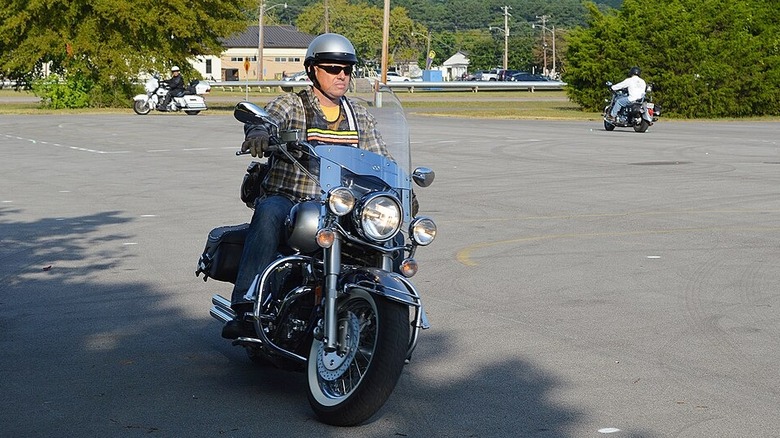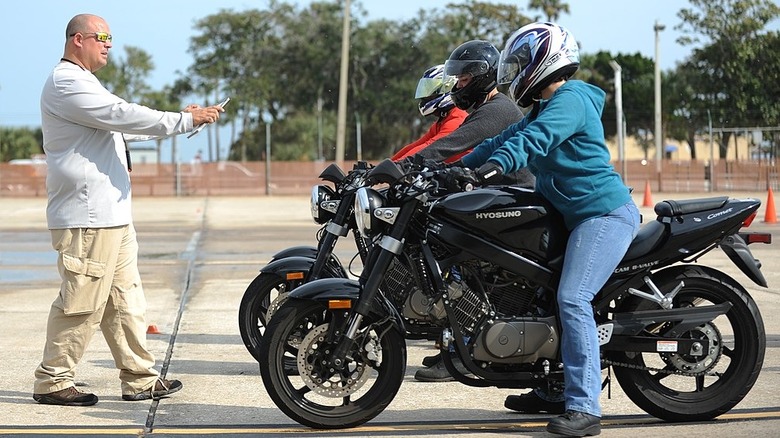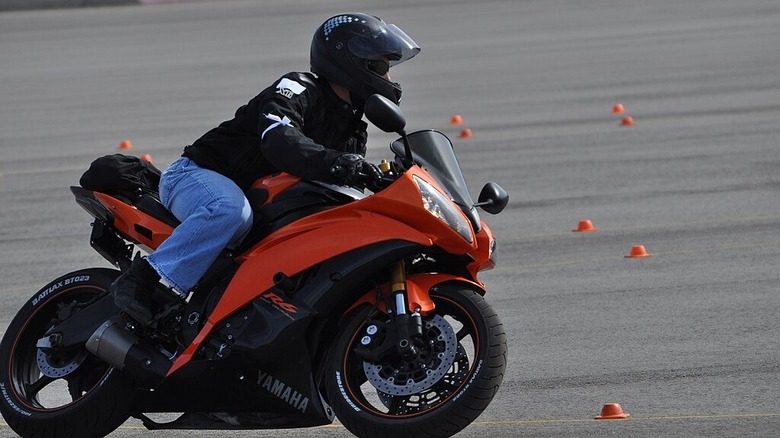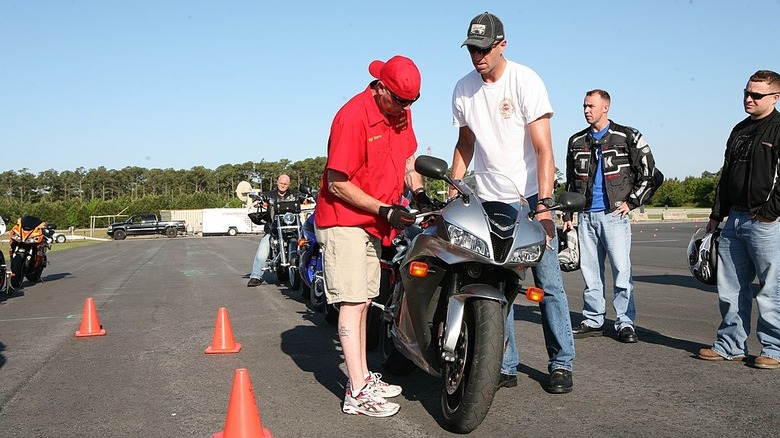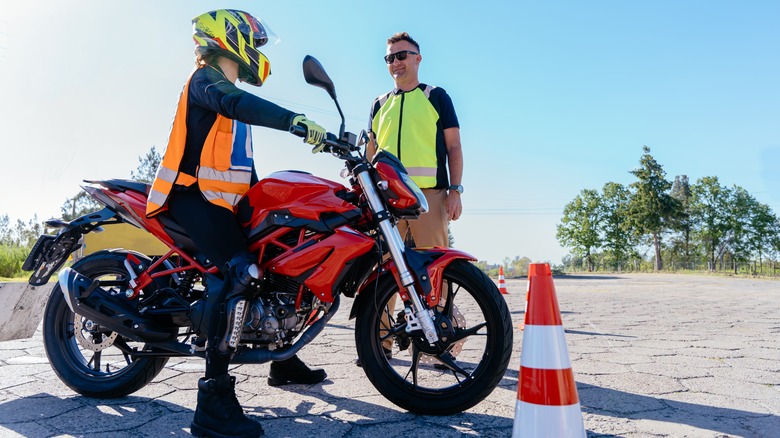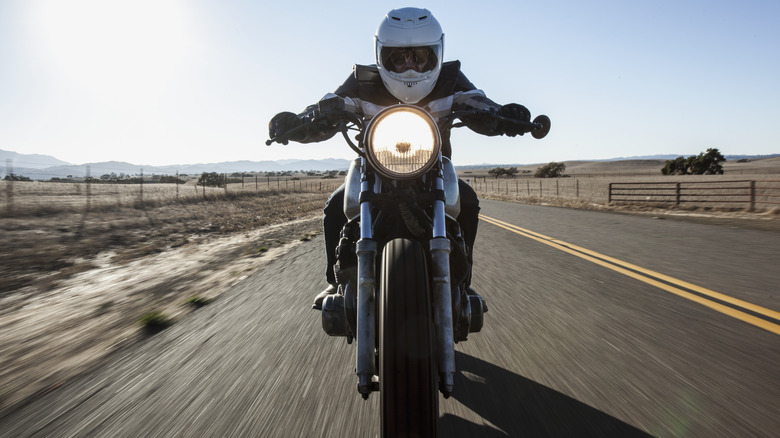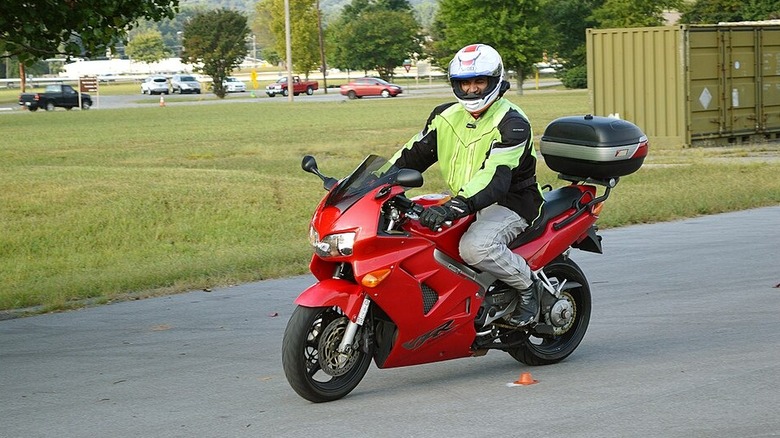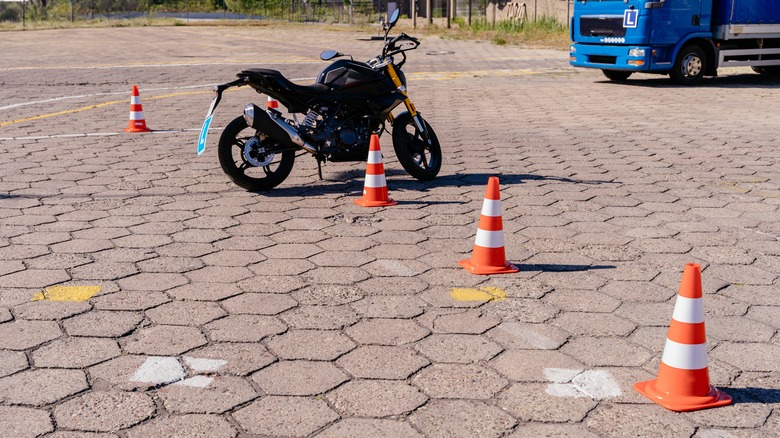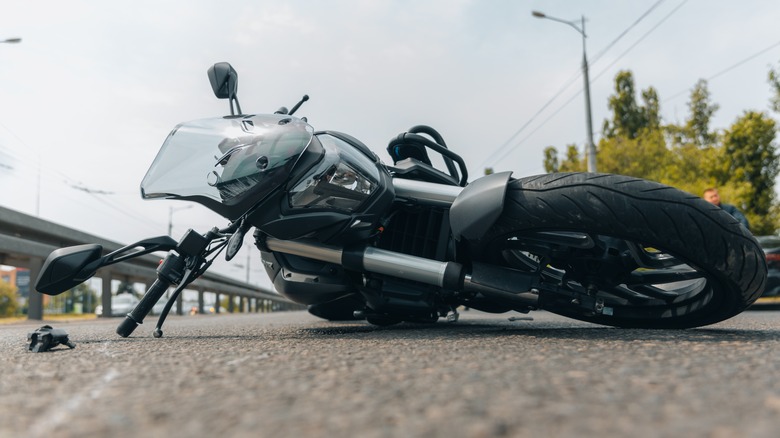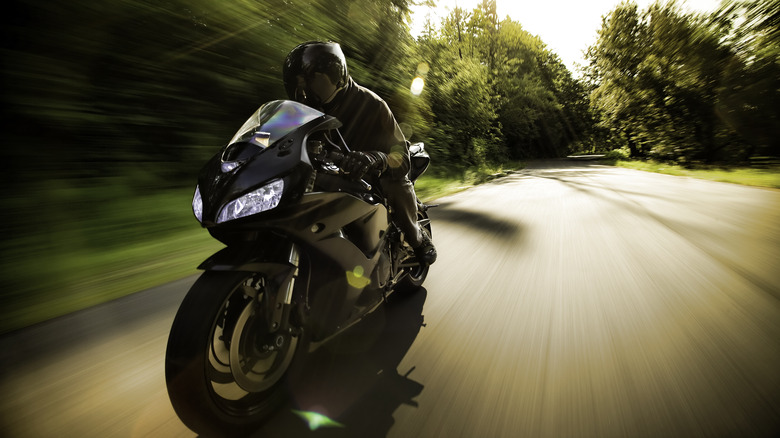10 Reasons A Motorcycle Safety Course Is A Good Idea
Every U.S. state offers a motorcycle license, but requirements can vary widely. In most places, it's possible to schedule a written and practical exam at the Department of Motor Vehicles and leave with a license. For many riders, though, it's not quite that simple.
Each state has its own requirements for motorcyclist testing, so depending on where you live, you could be asked to do anything from starting your bike to riding a figure-8 in the parking lot. Still, it's generally easy to obtain a motorcycle license, to the point where many riders don't have any formal training at all. It sounds convenient, but you might want to think twice before hopping on your new bike with zero practical experience or theoretical knowledge.
Taking a motorcycle safety course might sound silly, especially if you already have your motorcycle license. Most states don't require rider education prior to licensing, but there are plenty of smart reasons to take the class anyway, especially if you still believe some of the more questionable myths about motorcycle riding.
Here are 10 reasons why taking a motorcycle safety course is a smart idea, based on my personal experience — as a then-new rider taking a course and getting licensed — plus data to back up points about safety, insurance, and more.
Learn to ride (and use a clutch)
If you've never ridden a motorcycle, a course is invaluable for teaching the basics. It might seem easy, but the number of motorcycle accidents nationwide each year seems to suggest otherwise. Motorcyclist fatalities continue to increase each year, and the injury rate hovers around 837 per 100 million miles traveled (as of 2021) — almost double the rate of injuries in cars.
In short, riding a motorcycle is exceedingly dangerous, even if you do know what you're doing. A motorcycle safety course teaches you the essentials of riding — like how to use a clutch if you've never driven a stick shift — plus safety basics.
My first car was a 1972 Volkswagen Super Beetle, so I had the clutch thing down. And my exposure to motorcycles began at around age 12, so it's always been ingrained in me that motorcyclists have to ride defensively, as if they're invisible. The motorcycle safety course I took hammered that point home, and while our course didn't include the disturbingly graphic crash videos from driver's ed, the discussion did cover the dangers of being a biker on the road.
Of course, the kind of motorcycle you choose might be more visible than others. Some popular three-wheel trike motorcycles turn heads, and they don't need a motorcycle license to ride, depending on where you live. The DMV in California, for example, specifically categorizes motorcycles as having three wheels or fewer.
Low-stakes practice for the written test
Taking a written test to get your motorcycle license might not be too challenging, if you read your governing body's pamphlets on the subject. Still, written tests aren't everyone's cup of tea, and it helps to have some more thorough preparation in advance.
For the course I took in California, an in-class test was required to pass and get the DMV certificate. For riders 21 and older, passing the course doesn't necessarily matter a whole lot; the DMV won't revoke your M1 if they catch wind that you failed. But for under-21s, the course is required to even apply for a motorcycle license (you can get a permit without the course, though).
Regardless of requirements, taking a test during a motorcycle safety course has far lower stakes than failing the test when it counts. I also think that the multi-day course I took did more for my retention of the material than cramming for a one-time test. I still had to take the written exam at the DMV, but that was easy after the course. I also missed far fewer questions on my M1 test than I did on my Class C as a teenager fresh out of driver's ed.
That doesn't mean a motorcycle license has no requirements beyond testing, however. In most places, you also have to have an automobile driver's license to qualify for a motorcycle license.
Skip the in-person skills test
Not all U.S. states require a skills test for motorcycle licensing. In fact, the state with the most licensed riders — Alabama had over 1.6 million in 2022 — has no required skills test at all. It also doesn't require riders to have a vehicle driver's license, and a 16-year-old can become fully licensed after passing the written exam.
In contrast, most U.S. states require an in-person skills test — Washington D.C. is the only exception apart from Alabama, and D.C. mandates a rider course for everyone. Most states have primary skills and secondary skills tests in practice, where you are expected to do anything from a serpentine demonstration (described as a figure-eight at a set size) off-street to an on-street demonstration of standard street riding skills.
As a highly inexperienced rider (I'd previously only ridden a moped and ATV, the latter of which I bumped — not crashed! — into a tree), performing a figure-eight on some unfamiliar motorcycle in the DMV parking lot sounded awful. Especially after suffering through the vehicle driving test as a teen, I had no desire to perform in front of a DMV proctor and mess up or, worse, drop my (or someone else's) bike.
Imagine how thrilled I was to perform my serpentine demo in a giant parking lot with 20 other newbie riders who had no clue what they were doing, either. Then all of us who passed got to march into the DMV and skip the skills test altogether.
Avoid having to retake the test
How many teens do you know who have failed the written driver's education exam? It might be common, but it's not exactly desirable. The cost might not be too hefty (in California, it costs $7 per retake for a Class C driver's license), but the inconvenience adds up. The same applies to motorcycle licensing, except there's apparently a hard limit in some states.
In California, the DMV's motorcyclist guide states that you only have three chances to pass the written knowledge test before you have to re-apply (and pay again). Each attempt also costs $7. Extra costs aside, it's well-known that the DMV can be a frustrating place to spend the day — you could very well be there for hours — so prepping for that test and taking it seriously was my goal with the safety course.
In my course, we were given a workbook, had discussions in class, watched videos, took our written test to pass the course, and then put all of that into practice on the skills course (aka a giant parking lot). We practiced using hand signals, riding slowly, avoiding obstacles, stopping safely, and all manner of other things covered on the motorcycle test at the DMV.
Much of what's in the California motorcycle driver handbook, at least, is practical, and it's hard to internalize those things — especially "avoid being hit" — without real-world practice. For that reason, I think a safety course is invaluable.
Try out different motorcycles
The ability to test drive multiple motorcycles before buying one is probably one of the best perks of taking a motorcycle safety course. Most of the bikes available to you will be smaller, but you might find that a lightweight bike is just what you need.
Either way, you'll likely get some practice on more than one motorcycle. In California we have 10 hours of on-motorcycle instruction, which is plenty for you to figure out just how much power a 250cc bike can pack. Hopefully, it's enough to sway new riders against going out and buying the biggest, beefiest bike they can find.
Learning how to handle a smaller bike can take the ego out of any new rider, because while riding is arguably fairly easy, riding safely and confidently takes effort. Safety data also seems to suggest there might be a sweet spot in terms of bike size.
According to motorcycle fatality data from 2020 and 2021, 35% of motorcyclist fatalities for those years occurred on motorcycles between 501cc and 1,000cc. Interestingly, 1,001cc to 1,500cc bikes accounted for 23% of fatalities, while 1,501-plus ccs accounted for 7% (in 2021) to 8% (in 2020). Bikes up to 500cc similarly made up 8% of fatalities each year.
While the data isn't conclusive, one guess is that less experienced riders taking on too many cubic centimeters spells disaster, while experts with bigger bikes fare better.
Get a discount on insurance
While California is one exception, the majority of U.S. states use the Motorcycle Safety Foundation (MSF) curriculum. Other states like Arizona, Georgia, Massachusetts, and Pennsylvania have local programs and don't use MSF knowledge tests and handbooks either. Regardless of the program, it's possible you can get insurance breaks for passing a course; the California program even advertises potential insurance breaks as a perk on its website.
Companies like Allstate suggest you might be able to lower your insurance premium by taking a safety program in the last 36 months, while Progressive gives a discount for riders possessing a motorcycle license (which seems like a low bar) and passing a safety course.
It's not clear exactly how much of a discount you can get on motorcycle insurance, but anywhere from 5% to 10% seems to be common. Geico states it gives discounts of up to 10% for passing an MSF or Military Safety Course.
Most insurance companies also provide good driver discounts that also apply to motorcyclists who remain accident-free for a set amount of time, and you may also get a discount for insuring multiple bikes. For any rider — especially younger ones with higher insurance rates by default — all the discounts can add up. Given that MSF courses cost between $100 and $300, insurance breaks could easily recoup the investment in a year or two.
Face the safety reality check
A course highlights the need for proper gear, something many riders are lax about. A Department of Transportation (DOT)-approved helmet is a must on any safety course's equipment list, but local programs tend to have stricter requirements than BYOH. For example, my course required that I wore boots that covered my ankles. It didn't specify what kind of boot, and I saw some interesting footwear during my course, but safety was the primary motivator.
Fortunately, you can find motorcycle riding gear on a budget if you plan ahead. I'd recommend a brand-new helmet, mostly due to the ick factor of wearing used, but also because helmets can take a lot of hits without showing visible damage. It's not worth risking your noggin with a helmet you can't trust.
Safe riding is clearly still a factor, but the CDC says wearing a helmet reduces motorcyclists' risk of head injury by 69%. Helmets are reportedly 37% effective in "preventing deaths." I'm assuming rider abilities also impact how accidents play out, even with riders wearing their helmets religiously — another reason to take a safety course.
Interestingly, only two U.S. states currently have no motorcycle helmet law: Iowa and New Hampshire. Many others have partial laws, mostly related to people under a certain age (18 in some places, 21 or 26 in others) needing a helmet. It's interesting to note that in 2022, motorcycle fatalities were highest in a state with no helmet law for adult riders.
You don't need to own a motorcycle
One of the best perks of taking a motorcycle safety course is the fact that you don't need to have your own motorcycle to learn how to ride. This is a benefit not only because you won't be riding a new-to-you bike for an in-person skills test, but also because you can get a feel for different bikes before committing.
Practicing first will help you be better informed when it comes to buying (and test riding) a used bike (or a new one). Although one of the biggest concerns for motorcyclists is seat height, everyone is different, and two people of the same height could have vastly different inseams.
My mom is 5 feet, 2 inches tall and couldn't reach on an older Honda Nighthawk 750 (she later had the seat of her BMW cut down to fit). I'm 3 inches taller than her, I could touch the ground easily on the Honda and a BMW R1100R I thought I could ride as a newbie. But I bet you can guess which of us was better equipped to actually handle either one.
Owning a motorcycle doesn't necessarily make a difference in passing the skills test, either. In my course, there was an older gentleman who brought his own Honda Goldwing. He had never been licensed but had been riding for 30-something years. Unfortunately for him, he couldn't pass the skills test, despite his insistence that he was a good and safe rider with, we assumed, years of experience on that specific bike.
Keep your own motorcycle safe
Another good reason to take a motorcycle safety course? If you have a bike already, you're not risking its shiny paint for the learning experience. Odds are, most riders will drop their bike at some point, whether it's a slip up on the road or an oops in the parking lot.
If you're taking the skills test at a DMV location, they'll also require you to have a road-ready, fully insured motorcycle to take the test with (at least in California). It's kind of an odd expectation if the DMV is assuming you're a brand-new rider, but it's the rule regardless. Unlike borrowing someone's car for the driver's test, borrowing a motorcycle for the rider's test seems like it would be unlikely to work out well.
When it comes to buying a motorcycle, even the most affordable beginner bike will cost you a price higher than "free." In contrast, during your motorcycle safety course, if you drop a bike, you might lose some points if you're mid-demonstration for the skills portion. However, there are no real penalties unless you fail part of the exam, and there will definitely be someone nearby to help you pick the bike back up.
At the same time, odds are that the motorcycles in your safety course will be very small and not too powerful. They'll probably also be scuffed up a bit already, which helps with the psychological aspect of fearing the asphalt.
Start strong with good on-road habits
One huge reason why taking a motorcycle safety course is a good idea is simple: You don't know what you don't know. Taking a safety course is one of the most important tips for new riders because there is so much to learn. As my classmate proved, even if you spend 30 years on a motorcycle, that doesn't mean you know everything about riding safely.
The fact that a course is required for younger riders — at least in most states — is a good thing. Yet the age requirements for taking safety courses don't keep older beginner riders from skipping the training wheels. Personally, I think it's a bad idea to wait until you age out, because then, you're getting a permit based on written knowledge and no practical experience.
Because riding a motorcycle is statistically more dangerous than driving a car, it feels even more prudent to take a driver's ed course for motorcyclists. Driving a car comes a lot of weight and responsibility, and even if a state's laws don't reflect it, riding a motorcycle should come with an equivalent warning label.
Beyond personal experience, the data seems to back this idea up; the state with the least motorcycle fatalities in 2022 was not a state at all. Washington D.C. — which mandates a rider course for motorcyclists to become licensed and mandates helmets for all ages — had the fewest number of motorcyclist deaths with only four in 2022.

